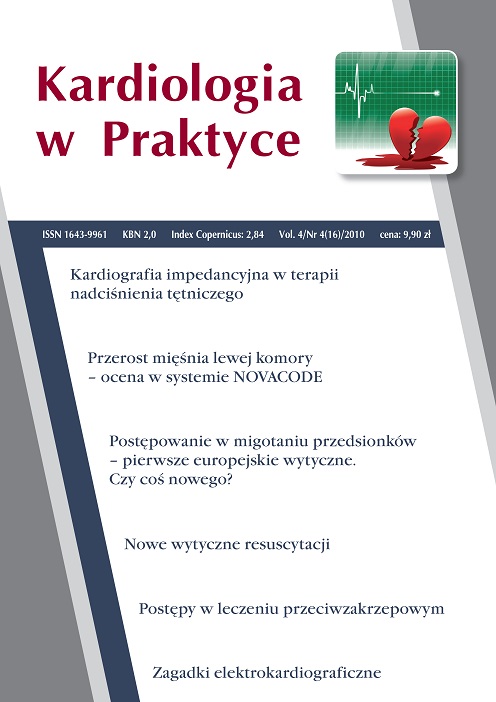Progress in antithrombotic therapy Review article
Main Article Content
Abstract
An ideal anticoagulant should be an oral anticoagulant that requires no routine anticoagulant monitoring, has a broad therapeutic window and predictable dose-efect response, has no drug or dietary interaction and minimal risk of adverse events. Recently two new anticoagulants have been approved while other are under clinical development.
Downloads
Article Details

This work is licensed under a Creative Commons Attribution-NonCommercial-NoDerivatives 4.0 International License.
Copyright: © Medical Education sp. z o.o. This is an Open Access article distributed under the terms of the Attribution-NonCommercial 4.0 International (CC BY-NC 4.0). License (https://creativecommons.org/licenses/by-nc/4.0/), allowing third parties to copy and redistribute the material in any medium or format and to remix, transform, and build upon the material, provided the original work is properly cited and states its license.
Address reprint requests to: Medical Education, Marcin Kuźma (marcin.kuzma@mededu.pl)
References
2. DeCaterina R., Husted S. Wallentin L. et al.: Anticoagulants in heart disease: current status and perspectives. Eur. Heart J. 2007, 28: 880-913.
3. Viskov C., Just M., Laux V. et al.: Description of the chemical and pharmacological characteristics of a new hemisynthetic ultra-low-molecular heparin, AVE5026. J. Thromb. Haemost. 2009, 7(7): 1143-1151.
4. Lassen M.R., Dahl O.E., Mismetti P. et al.: AVE5026, a new hemistnthetic ultra-low-molecular-weight heparin for the prevention of venous thromboembolism in patients after total knee replacement surgery – TREK: a dose ranging study. J. Thromb. Haemost. 2009, 7(4): 566-572.
5. Zhang Z.G., Zhang Q.Z., Cheng Y.N. et al.: Antagonistic effects of ultra-low-molecular-weight-heparin against cerebral ischemia/reperfusion injury in rats. Pharmacol. Res. 2007, 56(4): 350-355.
6. Wittowsky A.: New oral anticoagulants: a practical guide for clinicians. J. Thromb. Thrombolysis 2009, 29: 182-191.
7. Friedman R.J., Dahl O.E., Rosencher N. et al.; RE-MOBILIZE RE-MODEL RE-NOVATE steering committee. Dabigatran versus enoxaparin for prevention of venous thromboembolism after hip or knee arthroplasty: a pooled analysis of three trials. Thromb. Res. 2010, 126(3): 175-182.
8. Connoly S.J., Yusuf S., Eikelboom J. et al.; RE-LY steering committee and investigators. Dabigatran versus warfarin in patients with atrial fibrillation. N. Engl. J. Med. 2009, 361(12): 1139-1151.
9. Schulman S., Kearon C., Kakkar A.K. et al.; RE-COVER study group. Dabigatran versus warfarin in the treatment of acute venous thromboembolism. N. Engl. J. Med. 2009, 361(24): 2342-2352.
10. Becattini C., Lignani A., Agnelli G.: New anticoagulants for the prevention of venous thromboembolism. Drug Design, Development and Therapy 2010, 4: 49-60.
11. ROCKET study investigators. Rivaroxaban – once daily, oral, direct factor Xa inhibition compared with vitamin K antagonism for prevention of stroke and embolism trial in atrial fibrillation: rationale and design of the ROCKET AF study. Am. Heart J. 2010, 159(3): 340-347.
12. Lassen M.R., Raskob G.E. Gallus A. et al.; ADVANCE-2 investigators. Apixaban versus enoxaparin for thromboprophylaxis after knee repacement (ADVANCE-2). Lancet 2010, 375: 807-815.
13. Lopes R.D., Alexander J.H., Al-Khatib S.M. et al.; ARISTOTLE investigators. Apixaban for reduction in stroke and other thromboembolic events in atrial fibrillation (ARISTOTLE) trial: design and rationale. Am. Heart J. 2010, 159(3): 331-339.
14. Linkins L., Weitz J.: New and emerging anticoagulant therapies for venous thromboembolism. Current Treatment Options in Cardiovascular Medicine 2010, 12: 142-155.
15. van Ryn J., Stangier J., Haertter S.: Dabigatran etexilate – a novel, reversible, oral direct thrombin inhibitor: interpretation of coagulation assays and reversal of anticoagulant activity. Thromb. Haemost. 2010, 103: 1116-1127.
16. Harder S., Parisius J., Picard-Willems B.: Monitoring direct FXa-inhibitors and fondaparinux by prothrombinase-induced clotting time. Thromb. Res. 2008, 123: 396-403.
17. Crowther M.A., Berry L.R., Monagle P.T., Chan A.K.: Mechanisms responsible for the failure of protamine to inactivate low-molecular-weight-heparin. Br. J. Haematol. 2002, 116(1): 178-186.
18. Godier A., Durand M., Emmerich J. et al.: Efficacy of prothrombin complex concentrate to reverse the anticoagulant effect of the pentasaccharide fondaparinux in rabbit model. Thromb. Haemost. 2010, 105(1) [online].
19. Bianchini E.P., Fazavana J., Picard V., Borgel D.: Development of a recombinant antithrombin variant as a potent antidote to fondaparinux and other heparin deriveratives. Blood 2010 [online].
20. Paty I., Trellu M., Destors J.M. et al.: Reversability of the anti-FXa activity of idrabiotaparinux by intravenous avidin infusion. J. Thromb. Haemost. 2010, 8(4): 722-729.

